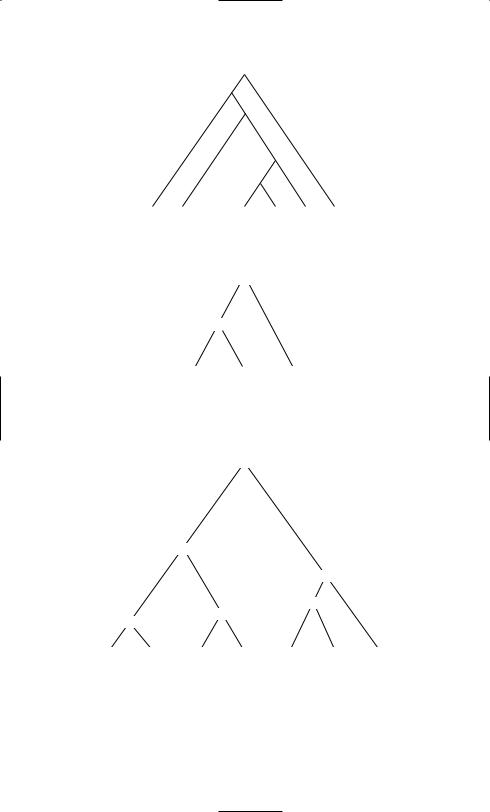
An_Introduction_to_English_Morphology
.pdf
DISCUSSION OF THE EXERCISES |
133 |
||||||||
|
|
|
|
|
|
|
|
|
|
|
|
|
N |
|
|
||||
|
|
|
|
|
|
|
|
|
|
|
V |
|
|
||||||
|
|
|
|
|
|
|
|
|
|
|
|
|
V |
|
|
||||
|
|
|
|
|
|
|
|
|
|
|
|
|
|
|
|
|
V |
|
|
|
|
|
|
|
|
|
|
|
|
|
|
|
|
|
|
A |
|
|
|
|
|
|
|
|
|
|
|||
|
|
|
N |
|
|
||||
re de compartment al |
is ation |
|
|||||||
The compounds are all right-headed, like this one:
|
N |
|
|
N |
|
N |
N |
N |
cabin |
crew |
training |
All the other compounds illustrated are contained within the largest compound, so only the structure of this largest one needs to be given:
N
|
|
N |
|
|
|
|
|
|
|
|
|
N |
|
|
|
|
N |
|
N |
|
|
N |
|
|
|
|
|
|
|
|
|
|
|
|
N |
N |
N |
N |
N |
N |
N |
air |
line |
cabin |
crew |
safety |
training |
manual |
According to the revised generalisation about stress formulated in Section 7.4, the main stress in this compound should be on safety – which seems correct.

134 |
AN INTRODUCTION TO ENGLISH MORPHOLOGY |
2. Unhappiness is straightforward:
N
|
A |
|
|
A |
|
un |
happi |
ness |
The alternative structure [un-[[happi-A]-ness]N]N is implausible because un- does not normally attach to nouns: *unjoy, *ungrief, *unfolly, *uncompassion. There are only a few exceptions: unease, unrest, unconcern.
On the other hand, unhappiest poses a problem. On the basis of its meaning, ‘most unhappy’, one expects the structure to be:
|
A |
|
|
A |
|
|
A |
|
un |
happi |
est |
However, the superlative suffix -est (just like the comparative suffix -er discussed in Chapter 5) does not get attached to bases that are more than two syllables long. This permits happy as a base, but not unhappy. It is as if, so far as the meaning is concerned, the structure is [[unhappi-]-est], but for the purposes of satisfying the phonological requirements for the base to which -est is attached, the structure is [un-[happiest]]. We thus have a bracketing paradox, though of a different kind from nuclear physicist and similar examples discussed in the chapter.
3. Both the meaning and the stress pattern of íncome tax rate suggest that it is a compound noun containing another compound noun: [[income tax] rate]. On the other hand, the meaning and stress pattern of high táx rate suggest that it is a phrase consisting of an adjective followed by a compound noun: [high [tax rate]].
In value ádded tax and goods and sérvices tax (two technical terms used in different countries for the same kind of tax), the immediate components seem clearly to be value added, goods and services, and tax. But is the whole item a phrase or a compound word? The fact that value added and goods

DISCUSSION OF THE EXERCISES |
135 |
and services are themselves phrases rather than words suggests the former; however, the fact that the stress is on the first component (rather than on tax) suggests that these are compounds of the kind that contain lexicalised (or at least institutionalised) phrases. (Compare the phrase inefficient services, which is not lexicalised: it sounds odd to say ‘inefficient sérvices tax ’ with the meaning ‘tax on inefficient services’.)
It was suggested that French history teacher might have the meaning ‘teacher of French history’ even when bracketed [French [history teacher]]. But no comparable bracketing for goods and services tax seems plausible, because it contains the conjunction and. This reinforces the counterargument based in the chapter on the implausibility of the bracketing [fresh [air fiend]].
Chapter 8
1. In my own active vocabulary, the forms that exist are indicated with ticks:
confer |
-ment |
-al |
-ence |
stress shift |
|
|
|
|
|
defer |
|
|
|
|
infer |
|
|
|
|
prefer |
|
|
|
|
refer |
|
|
|
|
transfer |
|
|
|
|
What this shows is that, although various noun-forming processes can be used with verbs in -fer, only -ence can be used with all of them. It is thus these forms (deference, inference etc.) that are formally the most regular. But that does not mean that -ence is semantically regular. For example, there is no way of predicting from the meaning of confer that conference corresponds semantically only to the meaning ‘discuss’ rather than to the meaning ‘grant, award’ (for which the corresponding noun is conferment). This confirms that, in word formation, formal regularity does not entail semantic regularity.
2. The corresponding past tense forms are bound, blinded, found, minded, reminded and wound. (This last form is spelled the same as wound ‘injure’, but is of course pronounced differently.) At first sight, it looks as if, even among these verbs, -ed suffixation is the regular way of forming the past, with just three exceptions that use vowel change instead. But blind ‘make sightless’ and mind ‘pay attention to’, as verbs, are arguably derived by conversion from an adjective and a noun respectively, while remind is

136 |
AN INTRODUCTION TO ENGLISH MORPHOLOGY |
derived from mind. Only bind, find and wind are basically verbs – and these are precisely the verbs within this group that use vowel change. So there is a case for saying that vowel change, not -ed suffixation, is the regular way of forming the past tense for basic verbs in -ind – that is, that the -ed form is blocked by the -ound form, which conforms to a smallerscale formal regularity affecting only three verbs.
3.(a) (i) singer
(ii)‘someone who sings’
(b)(i) cook (formed by conversion from the verb)
(ii)‘appliance for cooking’
(c)(i) thief
(ii)The word stealer is not often used on its own, but occurs in metaphorical contexts, such as scene-stealer ‘actor who attracts the attention of the audience to himself or herself, at the expense of other actors’.
(d)(i) cyclist
(ii)The word cycler is not used except in contexts specifying a destination or location, such as She is a regular cycler to work meaning ‘She regularly cycles to work’.
(e)(i) spy
(ii)It is hard to think of any context where ‘spier ’ might naturally occur.
(f ) (i) cleaner (with the sense ‘clean buildings, e.g. offices, as an occupation’)
(ii)The word cleaner can also mean a substance used in cleaning, as in oven-cleaner.
(g)(i) There is no word that means ‘someone who habitually prays’.
(ii)The word prayer exists, but is normally pronounced as one syllable rather than two, in which case it has the meaning ‘activity of praying’ or ‘utterance used in praying’ rather than ‘person who prays’.
(h)(i) flautist, flutist or flute-player
(ii)flute-player means ‘someone who plays the flute’.
The suffix -er is the most general and regular of the agent suffixes (meaning ‘someone who Xs’). However, for words of the form Xer, the agent meaning is blocked if some other word exists with that meaning, as in (b), (c), (d) and (e). The term flautist at (h) might be expected to block flute-

DISCUSSION OF THE EXERCISES |
137 |
player or flutist, but flautist is rather technical and not in wide common use, so the three terms exist side by side.
The divergence between formal and semantic regularity is illustrated by cooker and cleaner. Both are regularly formed, but are more or less irregular semantically in that cooker never means ‘someone who cooks’ and cleaner does not always mean ‘someone who cleans’.
4. With adjectival bases, the suffix -ish creates adjectives with the consistent meaning ‘somewhat X’. It is therefore semantically regular. The fact that some such derivatives are often listed in dictionaries (e.g. greenish, whitish) while others are not (e.g. longish, slowish) tends to suggest that these adjectives lack formal regularity. However, in my speech (though not in writing) almost any adjective can be a suitable base, as in fastish, toughish, boringish, importantish. For me, therefore, when suffixed to adjectives, -ish is both semantically and formally regular.
With noun bases, -ish usually means ‘resembling X’ (e.g. boyish, babyish) or ‘appropriate for X’ (e.g. slavish, bookish, tigerish), often with a derogatory connotation, but it can also mean ‘of nationality or group X’ (e.g. Swedish, Amish), with no such connotation. It is therefore not entirely regular semantically. Formally, too, it is irregular in that some of its bases are bound allomorphs (e.g. English, Irish, Spanish), others free (e.g. Scottish, Finnish); also in that some nouns that one might expect to serve as bases for -ish suffixation do not. e.g. *snakish, *armyish, *Chinish, *Greecish. What is more, these examples sound (to my ear) less plausible, or more contrived, than e.g. aggressivity and languidity, discussed in the chapter. Suffixation of -ish to nouns, unlike suffixation of -ity to adjectives, thus displays no evident formal regularity. With respect to both kinds of regularity, therefore, -ish words formed from adjectives differ from ones formed from nouns.
Chapter 9
1. Germanic: -ful, -ing, -less, adverb-forming -ly, adjective-forming -ly,
-ness, -th, un-.
Latin or French: -able, -ity, -ive, in-, re-.
2(a) -able : Mostly attaches to free bases (indeed, it can attach to almost any semantically appropriate transitive verb, e.g. wipable, understandable, pleasable), but sometimes also to bound ones (e.g. formidable, palpable, potable).
(b) -ful : Almost always attaches to free bases (a rare bound base being

138 |
AN INTRODUCTION TO ENGLISH MORPHOLOGY |
aw- in awful, which, because of meaning change, can no longer be plausibly regarded as an allomorph of awe).
(c)-ing : Attaches only to free bases.
(d)-ity : Attaches to some free bases (e.g. density, maturity), but more often to bound ones. Some of these bound bases are morphemes with no free allomorphs (e.g. in paucity, garrulity). Others are bound allomorphs of morphemes that are free in some contexts (e.g. sanity, whose base, rhyming with pan, has also a free allomorph sane that rhymes with pane; and sensitívity, whose base is stressed sénsitive when free).
(e)-ive : Like -ity, attaches to more bound bases (e.g. sensitive, aggressive, receptive, compulsive) than free ones (e.g. defensive, disruptive).
(f ) -less : Like -ful, attaches mostly to free bases, although some of its bases have lost their freedom historically (e.g. ruthless ‘without compassion’).
(g)-ly (as in the adverb happily): Always attaches to free bases.
(h)-ly (as in the adjective manly): Almost always attaches to free bases (a rare bound base being come- in comely ‘attractive’).
(i)-ness : Always attaches to free bases.
(j)-th : Attaches to some free bases (warm-th, tru-th), but more often to a bound allomorph of an otherwise free base, as in leng-th, streng-th, wid-th, bread-th.
(k)in-: Attaches mostly to free bases, as in in-sane, in-tangible, also to some bases that are so rare in a positive context (without negative in-) that they have effectively become bound, e.g. in-exorable, in-defatigable. The same applies to its allomorph [ ], spelled in-, im-, il- or ir-, and alluded to in Section 5.6.
(l)re-: As noted in Chapter 3, we need to distinguish between re- as it is pronounced in re-store ‘store again’ and re- as it is pronounced in restore ‘repair’. The latter often appears with bound bases, e.g. in recede, retain, refer. However, the re- of re-enter is the former, which is limited to free bases.
(m)un-: Almost always attaches to free bases (rare bound bases being
-couth, -kempt and -ruly in uncouth, unkempt and unruly).
3.To my ear, the neologisms grintable, bledgeful, dorbening, bledgeless, dorbenly, dorbenness, regrint, undorben sound more plausible words than dorbenity, bledgive, bledgely, dorbenth, indorben. I would not expect a native

DISCUSSION OF THE EXERCISES |
139 |
speaker to disagree with me over more than one or two of these items. My classification is therefore:
•likely in neologisms: -able, -ful, -ing, -less, adverb-forming -ly, -ness, re-, un-
•unlikely in neologisms: -ity, -ive, adjective-forming -ly, -th, in-.
4. Putting together the results of from questions 1–3, we arrive at the following table:
|
Source |
Status of bases |
In neologisms |
-able |
not Germanic |
mostly free |
yes |
-ful |
Germanic |
almost all free |
yes |
-ing |
Germanic |
all free |
yes |
-ity |
not Germanic |
mostly bound |
no |
-ive |
not Germanic |
mostly bound |
no |
-less |
Germanic |
almost all free |
yes |
adverbial -ly |
Germanic |
all free |
yes |
adjectival -ly |
Germanic |
almost all free |
no |
-ness |
Germanic |
all free |
yes |
-th |
Germanic |
mostly bound |
no |
in- |
not Germanic |
mostly free |
no |
re- |
not Germanic |
all free |
yes |
un- |
Germanic |
almost all free |
yes |
This confirms the suggestion in the chapter that, if an affix is Germanic, it is likely to attach to free bases, and to be available for neologisms. The correlation is not exact, however, since -th and adjective-forming -ly are exceptions. Conversely, if an affix is borrowed from Latin or French, we will expect it to attach mainly to bound bases and to be unavailable for neologisms, although in- and -able are each an exception to one of these expectations, and re- is an exception to both.
5.(a) dermatology: -derm(at)- ‘skin’, -(o)logy ‘science, area of expertise’
(b)erythrocyte: erythr(o)- ‘red’, -cyt(e)- ‘cell’
(c)pterodactyl: -pter(o)- ‘wing’, -dactyl- ‘finger’
(d)oligarchy: olig(o)- ‘few’, -archy ‘rule’
(e)isotherm: is(o)- ‘equal’, -therm(o)- ‘heat’
(f ) bathy- ‘deep’, sphere
Of these, all are bound combining forms except sphere. Therm occurs as a free form; but, as such, it means not ‘heat’ in general but ‘unit of heat equivalent to 100,000 British Thermal Units’, so should probably be regarded as a distinct morpheme from the combining unit -therm(o)-.

140 |
AN INTRODUCTION TO ENGLISH MORPHOLOGY |
6(a) In Old English, this distinction was expressed morphologically in some nouns, but not in all. In modern English, it is expressed in personal pronouns (I/me, she/her, he/him etc.), but not in nouns.
(b)This distinction is expressed in both Old and Modern English (Modern English (I/you) help versus (he/she) helps ; Old English (ic) helpe,
(´u¯) helpest, (he¯/he¯o) helpe´). Notice, however, that Old English, unlike Modern English, also distinguishes first person from second person.
(c)This distinction is expressed in Old English but not in Modern English. In the past tense, Old English distinguishes number (singular versus plural) but not person, while Modern English makes no morphological distinctions at all (except in was/were).
(d)This distinction is expressed neither in Old nor in Modern English. Even in Old English, all the plural forms are alike in any one tense (present or past) or mood (indicative or subjunctive). Any readers who know German will be able to confirm that, in this respect, Old English differs from German, where second person plural forms can be distinguished from third person plural ones (e.g. (ihr) kommt ‘you (plural) come’ versus (sie) kommen ‘they come’).
7.(a) break inherited; fragile borrowed from Latin
(b)break inherited; frail borrowed from French
(c)legal borrowed from Latin; loyal borrowed from French
(d)dual borrowed from Latin; two inherited
(e)nose inherited; nasal borrowed from Latin
(f ) mere inherited; marine borrowed from Latin

Glossary
accusative case – grammatical case usually exhibited by a noun phrase functioning as the direct object of the verb, and usually (but by no means always) expressing semantically the goal or patient of the action that the verb denotes. acronym – blend incorporating only the initial letters of its components, e.g. NATO for North Atlantic Treaty Organisation. (Abbreviations such as USA or BBC, in which the name of each letter is pronounced in turn, are not
acronyms.)
adjective – see word class. affix – prefix or suffix.
affixation – process of adding an affix.
allomorph – one of the variant pronunciations of a morpheme, among which the choice is determined by context (phonological, grammatical or lexical). For example, [z], [ z] and [s] are phonologically determined allomorphs of the plural suffix, occurring respectively in cats, dogs and horses. A morpheme with only one pronunciation is sometimes said to have only one allomorph.
allomorphy – choice of allomorphs, or (in respect of a morpheme) the characteristic of having more than one allomorph.
argument – noun phrase or prepositional phrase that is a required or expected concomitant of a verb. For example, sleep normally has one argument (The boy slept) while kick has two (The boy kicked the ball ) and introduce has three (The boy introduced his sister to the visitors).
article – see word class.
bahuvrihi – another term for exocentric, drawn from the terminology of traditional Sanskrit grammarians.
base – word or part of a word viewed as an input to a derivational or inflectional process, in particular affixation.
binary – of a tree diagram, having two branches (or no more than two branches) at each node.
blend – kind of compound in which at least one of the components is reproduced only partially, e.g. smog, combining elements of smoke and fog.
blocking – see semantic blocking.
bound morpheme, bound allomorph – morpheme or allomorph that cannot stand on its own as a word. A bound morpheme is one whose allomorphs are all bound. See also free morpheme.
141

142 |
AN INTRODUCTION TO ENGLISH MORPHOLOGY |
bracketing – see labelled bracketing.
bracketing paradox – inconsistency between the structure suggested by the syntactic or morphological properties of an expression and the structure suggested by its meaning.
case – grammatical category expressing the relationship of a noun phrase to the verb in its clause. See also nominative, accusative.
causative verb – verb meaning ‘cause to (be) X’. For example, the verb boil is causative in the sentence Ellen boiled the water, meaning ‘Ellen caused the water to boil’.
circumfix – a two-part affix, one part preceding and the other following the base.
cliché – expression that resembles an idiom in that it is conventional or institutionalised, but differs from an idiom in that its meaning is entirely derivable from the meanings of its components.
cognate – of words, derived from the same historical source. For example, the English word father and the French word père are cognate, both being descended (through Proto-Germanic and Latin respectively) from the same Proto-Indo-European word.
collocational restriction – restriction whereby a word, in the context of (or when collocated with) another specific lexeme, has a literal meaning different from its usual one. For example, the meaning ‘not sweet’ for the adjective dry is restricted to the collocation dry wine.
combining form – bound morpheme, more root-like than affix-like, usually of Greek or Latin origin, that occurs only in compounds, usually with other combining forms. Examples are poly- and -gamy in polygamy.
comparison – grammatical category associated with adjectives. Many English adjectives distinguish basic, ‘comparative’ and ‘superlative’ forms (e.g. hot, hotter, hottest).
compound – word containing more than one root (or combining form). See also primary compound, secondary compound.
conjunction – see word class.
conversion – the derivation of one lexeme from another (e.g. the verb from the noun ) without any overt change in shape. Some linguists analyse this phenomenon as zero-derivation.
cranberry morph(eme) – morpheme (or allomorph) that occurs in only one word (more precisely, only one lexeme).
defective – term applied to a lexeme that lacks one or more of the grammatical words (and the associated word forms) that most lexemes of its class possess. For example, the archaic verb lexeme ‘said’ (as in quoth he) is defective in that it has only a past tense form.
derivational morphology – area of morphology concerned with the way in which lexemes are related to one another (or in which one lexeme is derived from another) through processes such as affixation. For example, the verb lexeme is derivationally related to the nouns and
.
